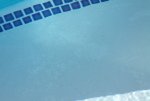Yes, your pool plaster has what has been known as "spot etching" for years. The appropriate term is now known as "white soft spotting." The spots have turned white over time because some cement compounds in these plaster areas has leached (some call this "weeping") out and has resulted in a high degree of porosity. The surface of these spots is still smooth (just like the rest of the unaffected surface) because there has not been any etching or aggressive action caused by aggressive water. In other words, these white spotted areas are weak, soft, and deteriorating and losing plaster material, even in balanced or positive SI water. The porosity is what makes these spotted areas lighter or whiter in color. The white spots go somewhat deep into the cement matrix, about 4 mm. It is not a calcium scale issue either. You would have to remove about an eight of an inch by sanding with sandpaper to remove the white spots.
You are right that the smooth non-whitened areas around the affected white areas is slightly gray in color. It is not a metal staining issue. It is not white like it should be and normally is. The overall grayness is due to the addition of calcium chloride by the plaster mixer into the cement mix. Therefore, the contrast between the two areas are significant enough to see. The grayness has increased since the beginning, and the white spots have becomes lighter in color over time as it loses material. This is an issue that sometimes develops within the first year of new plaster jobs. And the grayness of the plaster cannot be sanded off either.
There are usually several factors that combine to cause this to happen. Mainly, adding too much calcium chloride to the plaster mix (to speed up the hardening process), performing hard troweling too late in the process, and adding too much water while troweling trying to get the plaster surface smooth. Spraying down the plaster before filling, or filling the pool too early, can also contribute to this issue.
Finally, "white soft spotting" is not caused by aggressive water. Aggressive water early on would have sped up the white spots showing up, but isn't the cause to this plaster defect. Please don't do a "zero alkalinity" (very aggressive) treatment to try and remove the contrasting discoloration. It won't work and it will age (by etching) the plaster.



